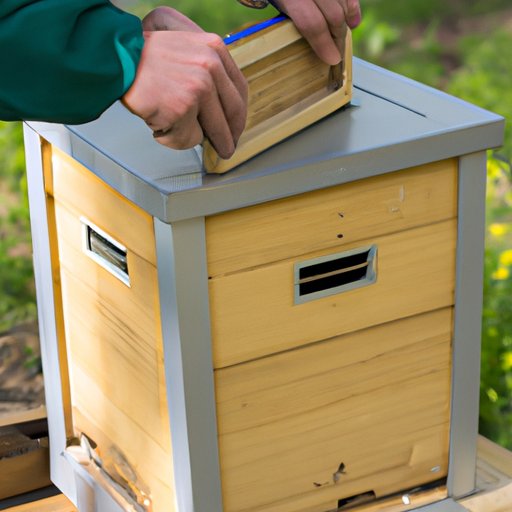Introduction
Beekeeping is a rewarding hobby that can be enjoyed by anyone, regardless of age or experience. It involves the care and maintenance of a beehive and its inhabitants, honey bees. Starting a beehive requires some knowledge of beekeeping basics and the right equipment, but it doesn’t have to be intimidating. With the right preparation and research, you can confidently begin your journey into the world of beekeeping.

Research the Basics of Beekeeping
The first step in starting a beehive is to educate yourself on the basics of beekeeping. Learning about the life cycle of honey bees and the process of making honey will help you understand the importance of their role in our ecosystem and the need for responsible beekeeping practices. Additionally, familiarizing yourself with common bee diseases, pests, and other potential threats to your hive will help you provide the best possible care for your bees.
There are plenty of resources available to help you learn the basics of beekeeping. The American Beekeeping Federation offers a variety of educational materials, such as books and webinars, as well as a mentor program to connect you with experienced beekeepers. Additionally, many local beekeeping organizations offer classes and workshops to help you get started.
Choose the Right Location for Your Beehive
Once you’ve done your research and feel confident in your beekeeping knowledge, it’s time to choose the right location for your beehive. When selecting a spot for your hive, consider factors such as sun exposure, wind protection, and proximity to sources of water and food. While bees can fly up to two miles in search of nectar and pollen, having a nearby flower garden or orchard will help ensure your bees have a reliable food source.
It’s also important to check the local regulations and zoning laws in your area before setting up your beehive. Some areas may require permits or have restrictions on the number of hives allowed. Contact your local extension office or agricultural department for more information.

Understand the Cost of Starting a Beehive
Before you begin setting up your beehive, it’s important to understand the associated costs. You’ll need to purchase the necessary equipment for your hive, including the hive body, frames, foundation, and protective clothing. Depending on the type of hive you select, the cost of equipment can range from $100 to $500. Additionally, you’ll need to purchase bees, which typically cost around $100 for a three-pound package.

Assemble and Install Your Beehive
Once you’ve purchased all of the necessary equipment, you can begin assembling your beehive. Most beekeeping equipment comes with detailed assembly instructions, so make sure to read them carefully. If you’re unsure of anything, contact the manufacturer or seek advice from an experienced beekeeper.
When installing your beehive, place it in an area that is sheltered from strong winds and direct sunlight. Position the entrance away from any high-traffic areas, such as walkways and driveways. To protect your hive from predators, consider installing a fence or other barrier around the area.
Source Your Bees
The next step in starting a beehive is to source your bees. There are two main types of bees used in beekeeping: Italian honey bees (Apis mellifera ligustica) and Carniolan honey bees (Apis mellifera carnica). Italian honey bees are the most popular choice, as they are docile and good honey producers. Carniolan honey bees are more resistant to disease and better able to survive cold winters.
Bees can be purchased from local beekeepers or online suppliers. Make sure to order your bees at least a few weeks before you plan to install the hive, as they need time to acclimate to their new environment. Once your bees arrive, transfer them to the hive as soon as possible and monitor them closely for signs of disease or distress.
Monitor and Maintain the Hive
Once your bees are settled in their new home, you’ll need to regularly inspect the hive and perform maintenance tasks. During inspections, look for signs of disease, pests, or other issues that may be affecting the health of the hive. Common maintenance tasks include harvesting honey, replacing old frames, and adding additional boxes when needed.
Regularly monitoring and maintaining your hive will help ensure that your bees remain healthy and productive. If you’re unsure of anything, reach out to experienced beekeepers for advice and guidance.
Conclusion
Starting a beehive can be a rewarding experience, but it does require some knowledge and preparation. Researching the basics of beekeeping and understanding the associated costs are essential steps in the process. Additionally, selecting the right location and sourcing quality bees will help ensure the success of your hive. With the right preparation, you can confidently start your journey into the world of beekeeping.
(Note: Is this article not meeting your expectations? Do you have knowledge or insights to share? Unlock new opportunities and expand your reach by joining our authors team. Click Registration to join us and share your expertise with our readers.)
